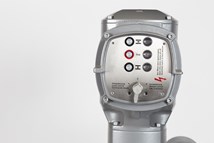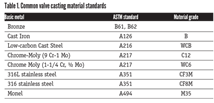Soft Goods in Actuators and Valves
Soft goods such as rings, gaskets, bushings, washers, seals and packing sets are widely used in valves and actuators.
#actuators
End users, on the other hand, operate the products and processes that use them. They change soft goods at certain frequencies to maintain smooth operations and assure reliability of the products as well as plant processes.
IN THE DESIGN
During the design phase for valves and actuators, manufacturers require specific fillings and compounds for soft goods. They specify those soft goods in the bill of materials (BOM) for their products to ensure that end users order the right soft goods for use with their manufactured valve or actuator. Usually, the part numbers do not show compound percentages and other details such as the filling type specified by the manufacturer. Instead, part numbers just show the part name and a short description of the materials. This is done because manufacturers usually work with specialized soft goods companies to manufacture those parts for them. In most cases, those soft goods companies also do not provide the detailed recipes of their products—they only provide a part number with a general size and base material description.
During the design phase, valve and actuator manufacturers usually consider several specifications when it comes to soft goods. They look at temperature ranges, operating media, service media and cycling frequency, depending on process conditions. For example, soft goods that are in contact with gases that are sour and have both moisture and particles would have different requirements from those in contact with gases that are sweet, dry and clean. Also, engineered soft goods designed for fluids might consider the presence of particles, gases and other contaminants.
The fillings and compounds that make up soft goods also have certain properties needed for valves and actuators in specific situations. The fillings might include glass fiber, carbon, bronze or graphite. The properties they may need include dielectric strength, hardness, coefficient of friction, total deformation, coefficient of thermal factor, wear, moisture absorption, temperature resistance and chemical resistance.1
End users typically catalog part numbers to ensure ordering “original” spare parts. However, there are situations where end users elect to go with local or nearby soft goods suppliers to get those spare parts. For example, an emergency may mean a valve or an actuator needs to be overhauled, but the end user’s spare parts warehouse does not have the required part in its stock. If placing an order for those spare parts from the original supplier or the manufacturer would take too long, an end user could elect to get the descriptions of those spare parts from the BOM, and then approach a local supplier for quick replacement parts.
But such a situation can be dicey—depending upon the criticality of the application, the location of the parts in the valve or the actuator, and the differences in properties between the “original” and the “fabricated” spare parts.
A CASE IN POINT
The following general example shows the major differences in properties, in this case between different polytetrafluoroethylene (PTFE) fillers. Non-filled PTFE or virgin PTFE is white in color and is capable of withstanding temperatures up to 450° F (232° C). Mineral-filled PTFE, meanwhile, is also white in color, but is capable of handling temperatures up to 550° F (288° C).2 If any of the mineral-filled PTFE soft goods on an actuator or a valve were replaced by a virgin PTFE, the probability of failure of those soft goods increases depending on the operating temperature of the application.
To carry this further, the following example shows how the same filler but with different percentages can affect the properties of a soft good. A 25%, glass-filled/75% virgin PTFE can handle a service temperature up to 550° F (288° C).3 Meanwhile, a 15% glass-filled/85% virgin PTFE can handle a service temperature up to 518° F (270° C).4 This means that if the normal operating temperature of a process is between 518° F (270° C) and 550° F (288° C), a failure can take place in that soft good if it was originally specified as a 25% glass-filled but was replaced by a 15% glass-filled.
SEALANTS
The higher the acrylonitrile percentage in nitrile rubber, the better the resistance to oil and fuel. At the same time, elasticity and resistance to compression set is adversely affected by that percentage. Figure 1 shows the different percentages of acrylonitrile and the effects on both the resistance to oil and the elasticity.6 This means that if a nitrile rubber with 50% acrylonitrile was replaced by a nitrile rubber with 20% acrylonitrile, the resistance to oil and fuel will increase and the probability of swelling will increase rapidly.
IN CONCLUSION
Manufacturers select soft goods in valves and actuators to suit the applications for which they are designed. Replacing those soft goods with products that are locally fabricated can be risky because of the different properties of different filling percentages, a situation made more complicated because those filling percentages are not usually published and provided in the manufacturers’ BOM.
Gary Burrows is senior applications engineer for Emerson Process Management–Valve Automation–Bettis. He has 30 years of experience in actuator and valve design, field service and application engineering. Reach him at gary.burrows@emerson.com.
Amr Atiah is an instrumentation engineer at Saudi Aramco–Ras Tanura Refinery. He has been in the instrumentation field 10 years and is currently on an 18-month internship assignment with Emerson Process Management. Reach him at amr.atiah@aramco.com.
References
1. www.buckeyerubber.com/ProdDisc.htm#Teflon
3. www.k-mac-plastics.com/data%20sheets/teflon-25%25GF-Data-Sheet.htm
4. www.matweb.com/search/datasheet.aspx?matguid=313108f956a6497d8883d535c753dac5&ckck=1
5. www.parker.com/literature/ORD%205700%20Parker_O-Ring_Handbook.pdf
6. www.123seal.com/seal-gasket/wp-content/uploads/HYDRAULIC-GROUP_ resize1.jpg
RELATED CONTENT
-
Pressure Relief Valve Basics – Spring-Loaded Safety Relief Valves
Learn for the first time or brush up on this common valve product.
-
Creating a Standard for Severe Service Valves
Severe service valves are offered in several standard designs, including non-return, isolation and control types.
-
An Overview of Butterfly Valves
A key advantage of selecting a butterfly valve is the reduction of space and weight to a system compared with other options such as ball, check, globe or gate valves.







 Unloading large gate valve.jpg;maxWidth=214)


